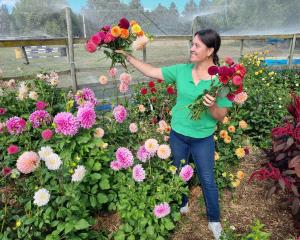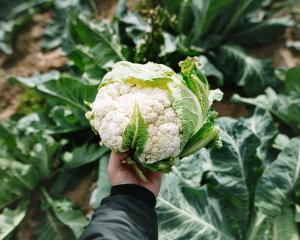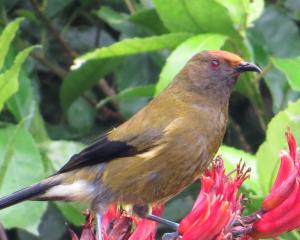Ikebana - the Japanese art of flower arranging - is an offshoot of Zen Buddhism. But there's no need to head to the Orient to study it - Dunedin has its own teacher.
Charlotte Morris, director of the Dunedin branch of the Sogetsu Teacher Association, has been doing ikebana for the past 18 years.
"What attracted me to ikebana is that it has simplicity - you can do an arrangement with one flower. You don't need heaps of flowers, although you can do an arrangement using heaps of them if you want to.
"Ikebana does not particularly emphasise flowers; all plant material can be used," Charlotte says.
Stones, driftwood, vines or even seaweed can all be incorporated in an arrangement.
Ikebana is really an art form, she says, and there is always a new technique or new materials she wants to use.
She grows most of her own materials but occasionally buys flowers.
Charlotte qualified as a teacher in 1998, but has only begun teaching pupils this year.
"I qualified when I was doing lessons with my teacher, Elizabeth McMillan," she says.
"The ikebana group that I belong to is part of the Sogetsu School of Ikebana, which has its headquarters in Japan. The curriculum is set by the school and consists of four textbooks, each with 20 lessons ...
"It would usually take two to three years to cover the four textbooks and then do the lessons to become a qualified teacher."
Ikebana has several points of difference from Western flower arranging, she believes.
"Unlike Western flower arranging, ikebana does not have competitions and no-one's arrangements are judged.
"I think we use a bigger variety of materials than Western arrangements, and any natural materials are used. The emphasis is on the beauty of the materials we use."
Ikebana arrangements involve a lot of technique, but the end result should look effortless.
In Sogetsu Ikebana, the basic principles are to have three lines - shin (the tallest), soe (the middle) and hikae (the shortest line or focal area). The arrangement should also have depth.
Many people in Dunedin who do ikebana display their arrangements at their workplaces or at clubs they belong to, Charlotte says.
"As a group we have done exhibitions in the museum, and at art galleries, shopping malls, churches, the public library and the university library".
Asked to sum up the essence of ikebana, she quoted Sofu Teshigahara, who established the Sogetsu School of Ikebana in 1926 - "Ikebana can be done by anyone, and displayed anywhere. Anything at all can be used as material for an arrangement."
Learn more:-
• Charlotte Morris will be teaching ikebana at the Mornington Church Community Centre on Saturdays, 1pm-5pm.
• Anyone interested in finding out more about ikebana can phone Charlotte on 467-9297 (evenings) or email charlotte.morris@clear.net.nz
About ikebana
Ikebana, one of the traditional arts of Japan, has been practised for more than 600 years, beginning when Buddhism was introduced to Japan in the 6th century. Offerings of flowers were placed on the altar in honour of Buddha, and by the 10th century, they were presented in containers. The altar offerings were the responsibility of the priests of the temple.
The oldest school of ikebana is Ikenobo, which began with a Kyoto priest who was so expert in flower arrangement that other priests sought him out for instruction.
By the late 15th century, ikebana was developing into an art form with fixed requirements. Texts were written, the oldest being Sendensho, a compilation covering the years from 1443 to 1536.
Rules were prescribed, and materials had to be combined in specific ways. In these early forms, a tall upright central stem had to be accompanied by two shorter stems; the three stems represented heaven, man, and earth.
By 1600, the religious significance of ikebana had diminished, and the arrangements gradually became a decorative lay art. The classical schools teach the seika or shoka style, as it is called in the Ikenobo school. It is characterised by a tight bundle of stems which form a triangular three-branched asymmetrical structure.
At the turn of the 20th century ikebana was a popular pastime for genteel Japanese women. Mr Unshin Ohara, an Ikenobo professor in Kobe, invented a form of ikebana done in a low bowl using shorter-stemmed Western flowers, and asked the Ikenobo school to include this design in their curriculum. The school refused, but gave him permission to teach his new form, and so began the Ohara school.
Ohara called his new form Moribana, meaning "piled-up", since it was not like the upright seika style. By 1915, most of the Ikebana schools had incorporated it into their own curriculum; it is still popular.
Another style, originated by Issotei Nishikawa, then began to attract interest because of its free and colourful approach. The chief exponent of this free style was Sofu Teshigahara, who founded the Sogetsu School in 1926.
The three main schools are Ikenobo, Ohara, and Sogetsu, but there are more than 2000 different schools of ikebana registered with the Japanese Ministry of Education.












